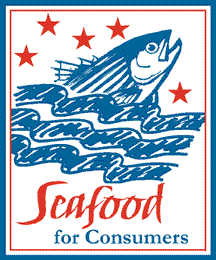
Number 10
November 7, 1999
"Overfishing" and reporting to Congress

"Overfishing" and reporting to Congress
 |
 |
The status of U.S. fisheries
As detailed in an Associated Press article by Melissa Robinson (98 Species Are Overfished, November 1, 1999), the National Marine Fisheries Service has just submitted its annual report to Congress on the condition of the fisheries resources in the U.S. Exclusive Economic Zone (generally waters from 3 to 200 miles off the coastline). A response to a legislative mandate to keep Congress informed of the condition of the fisheries being managed by the federal government, it is titled Status of Fisheries of the United States (October, 1999, National Marine Fisheries Service).In Ms. Robinson’s words, “The report found that 98 species are overfished - up from 90 last year - and another five are nearing that category. Since last year, 18 species were added to the overfished category; 10 were removed.” At face value, the fact that more species are considered “overfished” than were the previous year is pretty alarming, particularly considering the fact that both recreational and commercial fishermen and women today are contending with an unprecedented level of fishing restrictions. She then goes on to explain“The department (the National Marine Fisheries Service) cautioned that the net increase in overfished species might reflect a new, more complicated definition of overfishing, which considers both mortality rates for a species and stock size.” While this shows a conscientious writer doing a thorough job in a limited space, it doesn't go nearly far enough in explaining away the apparent increase in “overfished” stocks, so as an issue the increase has been leapt upon by the anti-fishing forces.
From the report: “The new statutory definition requires that status determination criteria must specify both a maximum fishing mortality threshold or reasonable proxy, and a minimum stock size threshold or reasonable proxy. Thus, species must be assessed according to whether the fishing mortality threshold is being exceeded and whether the minimum stock size threshold is being met. ‘Overfishing’ occurs for those species for which the fishing mortality rate exceeds the threshold fishing mortality rate or level required to produce the maximum sustainable yield (MSY) on a continuing basis. “Overfished” species are those for which the stock size falls below the minimum stock size required to produce MSY on a continuing basis. In the table, the term ‘overfished’ can apply to either conditions where ‘overfishing’ is occurring, or where the stock is ‘overfished,’ or both.” (emphasis added)
Of particular concern is one of the two criteria for determining if a fishery is “overfished.” A fishery is considered overfished if “the stock size falls below the minimum stock size required to produce MSY on a continuing basis.” In spite of the fishery being designated as overfished, there is no requirement that fishing be the cause of the reduced stock size. What this means is that, no matter what the reason, if a fish stock isn't as large as it should be, it is automatically considered to be “overfished.” (we have to interject that the stock only has to fall below a certain size in the area where NMFS is looking for it, not throughout its total range). So, regardless of rampant coastal development, regardless of the impact of meteorological cycles on the migrations of fish stocks, regardless of natural variations in the population of the species or its predators or prey, regardless of declining water quality, in fact regardless of any of a myriad of man-made or natural events that affect the population of a species, in the waters managed by the National Marine Fisheries Service not enough fish automatically equates to too much fishing. It seems like a dream scenario for developers, polluters, or any of the anti-fishing groups intent on severely restricting the existing commercial fishing industry, doesn't it? Or for those bureaucrats intent on building careers on an unintended yet none-the-less tragically real foundation of repossessed fishing boats and what used to be commercial docks but are now waterfront condominiums. No matter what the reason, if there aren't enough of a particular species of fish in a particular area, the federal government is going to designate the stock overfished.Once a fishery is given that designation, it then seems logical to assume that it should be able to be returned to the desired level of abundance by further restricting fishing effort. So that's what's done.
How about the overall picture?
The report to Congress states “Based on the criteria specified in the Magnuson-Stevens Act, the Report on the Status of Fisheries finds that 98 species are listed as ‘overfished,’ 127 species are listed as ‘not overfished,’ and 5 species are considered to be ‘approaching an overfished condition....’” As it stands, this appears to be a pretty fair indication that there are serious problems with almost half of our fisheries, problems most easily, but as we've already seen, not necessarily attributed to fishing. But then the sentence concludes, “...for 674 species, the status relative to ‘overfished’ is ‘unknown.’”The report considers over nine hundred species. It's been determined by NMFS that about a hundred of these (just twelve percent) are “overfished.” In each of these one of the reasons might be excessive fishing. But in the overwhelming majority of fisheries in the EEZ- eight hundred or eighty eight percent - there are either enough fish (therefore they aren't considered “overfished” by the National Marine Fisheries Service) or no one has bothered to figure out whether there are or not. And yet the title of Ms. Robinson’s article focuses on the ninety eight stocks that are in trouble and naturally, considering the terminology used in the report, assumes that this is because of overfishing.
Why the focus on fishing?
The reason for this focus in Ms. Robinson’s article is obvious. She's following the lead NMFS established in the report. But why was that lead established? If we consider all of the man-made and natural factors that could affect the numbers of a particular species of fish in a particular area - our Exclusive Economic Zone, for instance - it becomes apparent that most of them are beyond the control of fisheries managers. They can't do anything to control the weather, climate, oceanographic conditions or other large scale natural phenomena. They can't do anything to control the distribution and concentration of the hundreds of pollutants that have been pumped into our atmosphere, oceans and estuaries for decades. They can't do anything about our population's mass migration to the coasts, and the habitat degradation and destruction and non-point source pollution that accompanies it. The list of factors they can't control is just about as long as the list of factors that are impacting our fisheries.But they can control fishing, and in the case of commercial fishing they can control it exceedingly effectively (they aren't that good at controlling recreational fishing, but considering that the taxes recreational anglers pay for pursuing their hobby support a large part of the fisheries management establishment's budget, they probably don't want to be (
for more on this issue ). So, as far as NMFS in its report to Congress seems to be concerned, that's where we aim all the blame for there not being enough fish. That's where NMFS expends virtually all of its fisheries management effort, and the status of the stocks and their continued declines reflect that.
To be sure, in many instances fishing has been partly or entirely responsible for depleted fisheries. Just as certainly, it hasn't been in others. But our total management focus on fishing doesn't differentiate. From the management perspective this means that we are squandering scarce research, administrative and enforcement resources in efforts to “manage” the fishing effort in fisheries where fishing effort isn't the primary factor, and in turn are forced to scrimp in fisheries where it is. From the seafood perspective it means that fishermen are prevented from harvesting, and consumers from consuming, fish from fisheries where the level of fishing has nothing to do with the size or the health of the stock. This seems to be slightly less than the best way to do it.
Is there an alternative?
Assuming that we had to spend hundreds of millions of dollars every year on “managing” fisheries, until recently there wasn't any alternative. But today, thanks to bargain-basement prices on computing power, an explosion in the amount of available information and a delivery system - the internet - that makes that information instantaneously available and useable, and a much wider and deeper understanding of oceanographic processes, we're on the verge of being able to identify and quantify other factors that impact on fish stocks. Understanding the role of factors like changes in ocean currents that influence spawning, juvenile survival or the spatial distribution of adults, destruction of habitat that is critical to particular species at vulnerable life stages, or low-level contaminants that reduce the viability of eggs or larvae, is now within our grasp. We can model entire ecosystems, complex predator/prey relationships and the movement of pollutants through the food chain. And we can begin to estimate their short- and long-term effects on fish populations. We no longer have to be limited by the
concept that fishing mortality is the only factor to be concerned about in managing our fisheries - though it's still the only one we can control.
A simple suggestion
If our fishery management system is going to advance apace with our understanding of the physical, chemical and biological systems in the world's oceans, it's going to have to account for these other factors. We can't afford, either environmentally or economically, to continue with the pretense that not enough fish always means too much fishing. An easy first step in this direction would be a requirement that fishery management plans include an estimate of the relative impacts of the major anthropogenic and natural factors on the particular stocks being managed. This would allow us to begin to look at fisheries management as a rational process of devoting scarce management resources to those factors that can and should be managed and not wasting them on those that shouldn't. We've got twenty years of increasingly stringent restrictions on commercial harvesting behind us and large numbers of fisheries still considered overfished. This argues compellingly that factors other than commercial harvesting are at work. Now that we possess the capabilities to identify those other factors, why aren't we?It's time that we stopped managing fishermen and started managing fisheries.

![]()
| FishNet USA is distributed to over 1500 elected and appointed officials, media representatives, individuals and organizations with an interest in fisheries issues via fax and email. It is supported by Atlantic Capes Fisheries, the Fishermen’s Dock Cooperative, Lund’s Fisheries, Export, Inc., Agger Fish Corp., and Viking Village Dock |